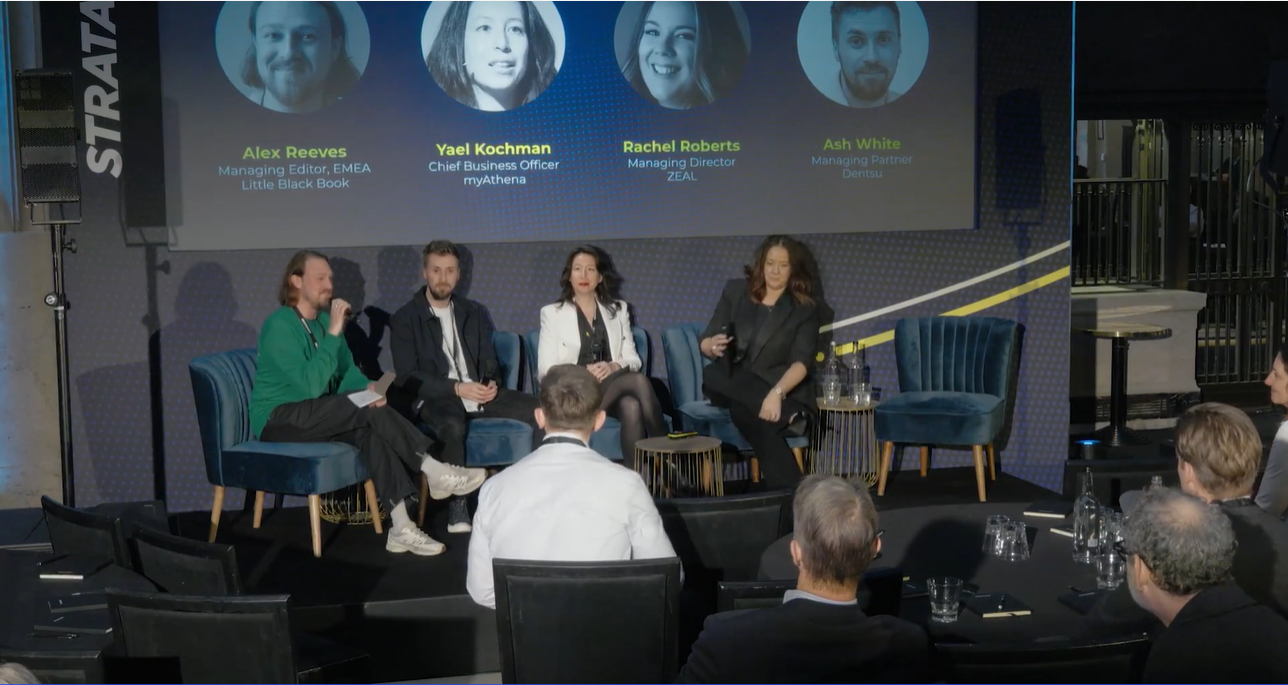




The role of creativity in retail media networks (RMNs) is more crucial than ever. That was the resounding message from a masterclass at the What’s In-Store for Retail Media event in London. The conversation, moderated by Alex Reeves, Managing Editor of Little Black Book, explored how brands and agencies can harness technology, data and creative expertise to enhance retail media strategies and drive results.
The panel featured Ash White (Managing Partner for Retail Media, Dentsu), Yael Kochman (Chief Business Officer, myAthena), and Rachel Roberts (Managing Director, ZEAL Creative) — each offering a unique perspective on how creativity is evolving in the retail media landscape.
With the limits of segmentation and data-driven targeting being tested by privacy regulations and evolving consumer behavior, creative is increasingly emerging as a primary lever for effectiveness. “Creative is the new targeting,” Kochman remarked, reflecting a shift in mindset. In an age when shoppers are inundated with messaging, bold, contextually relevant, and mission-led creative is essential for cutting through the noise.
Roberts echoed this sentiment, highlighting the need to “build stories from the shelf out.” Retail environments are cluttered — with thousands of products and promotions competing for attention — and marketers must understand shopper context to create moments of genuine impact.
Traditionally viewed as a lower-funnel conversion tool, in-store media has often been pigeonholed. But today’s RMNs offer far more than a path to purchase — they’re a canvas for brand storytelling. As White explained, effective in-store creative must be assessed differently: “If you’re buying premium CPM inventory hoping for ROAS, that’s not what that’s there to deliver.”
Instead, premium placements should support brand KPIs, inspiring and guiding shoppers in ways that align with both mental and physical availability. The most successful retail media campaigns don’t just translate TV spots to shelf edges — they contextualize messaging for micro-moments.
While creativity leads, technology plays an essential supporting role. From content automation to real-time measurement and optimization, tech is empowering marketers to be bolder, faster, and more agile.
myAthena is using AI to streamline content production — from briefing and directing creators to generating interactive, shoppable ads. But, as Kochman noted, the goal isn’t to replace human creativity but to enhance it: “We still need real people — customers, creators, brand reps — delivering authentic stories.”
White pointed to advancements in content management systems (CMS) and digital screen networks that allow retailers to optimize campaigns in real time, moving beyond static cardboard displays to dynamic experiences.
For retail media to thrive creatively, collaboration across the value chain is vital. That includes alignment between brands, agencies, retailers and technology partners.
The panel stressed the need for more open and transparent creative processes. While some progress has been made, particularly in agency–brand partnerships, panelists called for retailers to play a more proactive role. Standardized creative guidelines, collaborative briefing platforms, and shared campaign goals were cited as mechanisms to accelerate progress.
ZEAL’s Roberts also underscored the importance of involving shoppers in the creative process — drawing on real-time shopper panels to test, iterate, and refine content.
If creativity is to be valued, it must be measured meaningfully. The panel agreed that legacy metrics like ROAS are no longer sufficient, particularly for brand-building efforts.
Instead, Kochman proposed metrics like “sales per creative” to better understand long-term impact, while Roberts advocated for considering “return on retailer relationships” (RORR) to capture the value of deeper brand–retailer collaboration.
White noted that new tools — from creative effectiveness scoring to attention-based studies — are helping the industry move beyond basic conversion metrics and evaluate what truly drives engagement and influence.
So what does outstanding RMN creative look like a year from now?
It will be relevant, contextual, and inspiring. It will be designed from the shelf out, not resized from above-the-line assets. It will use technology as an enabler, not a replacement. And most importantly, it will reflect real collaboration—with shoppers, retailers, and brands aligned on shared goals.
As the panel concluded, this future isn’t a pipe dream. Some of the best brands are already moving in this direction. For those willing to rethink creative norms and embrace the full potential of RMNs, the opportunity is clear: to make in-store media not just effective, but unforgettable.
Key Takeaways:
Unlock the insights—watch the full masterclass here.
Explore every session from London’s What’s In Store for Retail Media Networks event here.